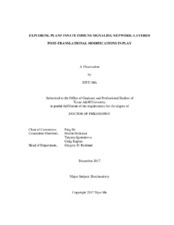| dc.contributor.advisor | He, Ping | |
| dc.creator | Ma, Xiyu | |
| dc.date.accessioned | 2019-01-16T21:26:41Z | |
| dc.date.available | 2019-12-01T06:33:58Z | |
| dc.date.created | 2017-12 | |
| dc.date.issued | 2017-12-14 | |
| dc.date.submitted | December 2017 | |
| dc.identifier.uri | https://hdl.handle.net/1969.1/173243 | |
| dc.description.abstract | Prompt activation of pattern recognition receptors (PRRs) upon microbial infection is essential for hosts to defend against pathogen attacks. Plant Botrytis-induced kinase 1 (BIK1) family receptor-like cytoplasmic kinases are key immune regulators associated with multiple PRRs, including the flagellin receptor complex FLS2-BAK1 in arabidopsis (Arabidopsis thaliana). Upon flagellin perception, BAK1 directly phosphorylates BIK1, leading to BIK1 dissociation from the FLS2-BAK1 complex to relay immune signaling. How BIK1 activation is regulated and how the signal is transduced downstream remain largely elusive.
In this dissertation, we found that flagellin perception triggers rapid monoubiquitination of BIK1 and its homolog PBL1 in planta. Time course and mutational analyses suggest that flagellin-induced BIK1 phosphorylation precedes BIK1 monoubiquitination. We further identified an RING-type E3 ligase LUCKY1 that interacts with BIK1 and monoubiquitinates BIK1 at multiple sites. Mass spectrometry and mutational analyses uncovered that the BIK1^9KR mutant with nine lysine residues mutated into arginine eliminated ubiquitination without sacrificing BIK1 kinase activity. Phenotypic analysis with transgenic plants expressing BIK1^9KR suggested that ubiquitination of BIK1 positively regulates BIK1 function as well as plant immune responses. Moreover, we found that flg22-triggered ubiquitination of BIK1 does not regulate BIK1 stability but controls ligand-induced BIK1 dissociation from receptor FLS2.
Recognition of pathogen-associated molecular patterns (PAMPs) via PRRs triggers a transient spike of secondary messengers such as Ca^2+ and phosphatidic acid (PA) in plant. How lipid signaling is tightly controlled to modulate PA production in immunity remains largely unknown. Here we show a PA synthesis diacylglycerol kinase DGK5 functions positively in plant immunity and is differentially regulated by two phosphorylation events. Upon PAMP activation, the PRR-associated cytoplasmic kinase BIK1 directly interacts with DGK5 and phosphorylates DGK5 at Ser-506. In addition, PAMP-activated MAP kinase 4 (MPK4) phosphorylates DGK5 at Thr-446 independently of BIK1. Interestingly, phosphorylation at Ser-506 by BIK1 appears to positively regulate DGK5 function while MPK4-mediated Thr-446 phosphorylation possesses a negative impact. Our findings reveal a mechanism that how PRR complex activation directly switches on lipid signaling to orchestrate innate immunity. | en |
| dc.format.mimetype | application/pdf | |
| dc.language.iso | en | |
| dc.subject | Plant innate immunity | en |
| dc.subject | Receptor-like cytoplasmic kinase | en |
| dc.subject | Protein monoubiquitination | en |
| dc.subject | Protein phosphorylation | en |
| dc.title | Exploring Plant Innate Immune Signaling Network: Layered Post-translational Modifications in Play | en |
| dc.type | Thesis | en |
| thesis.degree.department | Biochemistry and Biophysics | en |
| thesis.degree.discipline | Biochemistry | en |
| thesis.degree.grantor | Texas A & M University | en |
| thesis.degree.name | Doctor of Philosophy | en |
| thesis.degree.level | Doctoral | en |
| dc.contributor.committeeMember | Dickman, Martin | |
| dc.contributor.committeeMember | Igumenova, Tatyana | |
| dc.contributor.committeeMember | Kaplan, Craig | |
| dc.type.material | text | en |
| dc.date.updated | 2019-01-16T21:26:41Z | |
| local.embargo.terms | 2019-12-01 | |
| local.etdauthor.orcid | 0000-0003-4283-6781 | |


